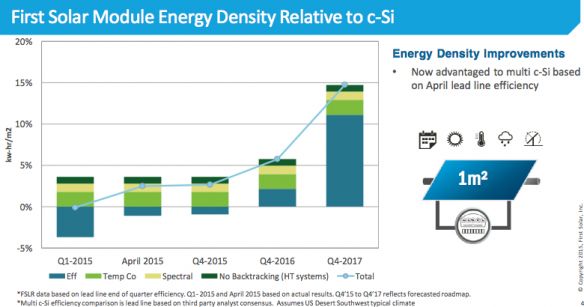We covered the recent First Solar earnings call, and aside from YieldCo fever, one topic from the presentation really stands out: First Solar's best production line is now shipping solar modules with efficiencies of 16.3 percent.
In 2011, First Solar's module conversion efficiency was 11.6 percent.
Earlier this year, First Solar set a record of 21.5 percent for a cadmium telluride solar cell. But First Solar has also been able to drive improvements in cadmium telluride PV from the lab into production. Some of First Solar's recent progress might also be attributable to its acquisition of GE's cadmium telluride effort.
First Solar had a full fleet average efficiency of 14.7 percent in the first quarter, an improvement of 0.3 percent from the previous quarter. First Solar's best line efficiency averaged 15.6 percent for the quarter, an improvement of 0.8 percent from last quarter and a 1.4 percent improvement versus Q1 of 2014. CEO Jim Hughes noted, "This improvement is the largest sequential and year-over-year increase in our lead line efficiency in the history of the company."
Raffi Garabedian, First Solar's CTO, told GTM in a previous interview, "We’ve proven that cadmium telluride can beat multi [-crystalline silicon] at the research cell level (21.5 percent vs. 20.4 percent). Now we’re starting to prove that we can climb the same hill at production scale -- all consistent with our module roadmap. It takes time and a lot of effort, but our rate of improvement is far better than what we’re seeing in the silicon field."
Yingli specs 15.6 percent for its multicrystalline solar panels modules and delivers 17.2 percent with its n-doped mono silicon. Trina specs a 15.9 percent (max) multicrystalline panel. SolarWorld specs a 17-percent-efficient mono panel.
During the earnings call, the First Solar CEO said that "conversion efficiency is a narrow measure of overall end modular performance, while energy yield produced is a more comprehensive and superior metric." He added, "We feel that we are well positioned to compete with any commercial crystalline silicon technology available."
The CEO also advised that the company's "crystalline silicon competitors typically calculate record efficiencies using the aperture area of the module. We calculate efficiency on a full area basis. Our 16.3 percent efficiency announced today would equate to a 16.9 percent aperture area efficiency, It's also important to understand that our 16.9 percent aperture efficiency is in high-volume commercial production and not in a laboratory."
The company believes it can hit ~19.5 percent efficiency in 2017. It also sees credible long-term paths to 23-percent-efficient and 25-percent-efficient CdTe cells.
Modules built at the company's Malaysian facility have a cost of less than 40 cents per watt.

***
Thanks to Seeking Alpha for the transcript of the earnings call.



